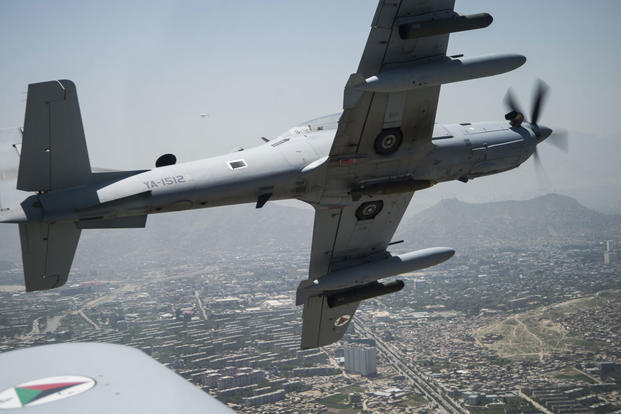An Afghan A-29B Super Tucano attached to the Air Force's training program crashed last year due to a sudden malfunction in the engine's propulsion system, but the service remains puzzled over how best to characterize the abrupt mishap, according to a recent investigation report.
Simulating a "close-air attack" roughly 35 miles from Moody Air Force Base, Georgia, an Afghan student pilot and an American instructor pilot assigned to the 81st Fighter Squadron were flying in a two-aircraft formation on March 6, 2017, when the pilots noticed a significant reduction in propeller speed, the Air Education and Training Command investigation board report said.
The report, released Wednesday, noted the engine retained "some degree of thrust, but was incapable of sustaining level flight."
Earlier in the flight, the instructor pilot, sitting in the back seat, noticed a "fault" in the system, but continued the flight for the aircraft, call sign "Bronco 92," the report said.
Related content:
- Air Force Chooses AT-6, A-29 for Secondary Light Attack Experiment
- Afghan Air Force to Get More A-29 Super Tucanos
- From Old Pilots to New Planes, Air Force Chief Talks 'New Ways of Doing Business'
About an hour later, as the student pilot began practicing the second sequence of close-air attack maneuvers, the power management system malfunctioned, and the instructor pilot immediately initiated "Compressor Stall" checklist protocols.
"Alright, looks like we got a compressor stall or something," the instructor pilot said over the radio transmission while talking with wingman Bronco 91.
The instructor pilot cycled the power management system between auto and manual a few times before placing it in manual for the rest of the flight.
This decision did not have any apparent effect on aircraft performance, the investigation found.
In the three minutes the instructor pilot attempted the switch and "continued to balance throttle inputs with engine limits seeking maximum performance from the aircraft," the plane still didn't completely recover.
Bronco 91 called in the emergency for Bronco 92 to enter nearby Homerville Airport's airspace. The instructor pilot diverted toward Homerville in an attempt for a straight-in landing nearby.
While the instructor pilot's intent was fly straight to Homerville, "cockpit visibility restrictions from the back seat caused him to initially fly a northeasterly heading as he visually acquired Homerville in the right-hand side of his canopy," the finding said.
The report, authored by Accident Investigation Board president Col. Michael Snell, stated that this created an unnecessary delay.
"The initial heading flown to allow the [mishap instructor pilot] to visually acquire Homerville and the ensuing task saturation resulted in a longer ground track than intended," Snell wrote in his conclusion.
Both the instructor pilot and the student pilot ended up ejecting from the aircraft 300 feet from the ground a mile and half from the airport. Bronco 92 went down 5 minutes and 26 seconds after the propulsion system malfunctioned.
The instructor pilot sustained minor injuries. The loss of aircraft and subsequent damage to the property was estimated at $17.7 million, the Air Force said.
The service trains Afghan pilots on the attack plane at Moody. The training program, which began in 2015, will ultimately train 30 pilots and 90 maintainers through 2018 at the base, according to the Air Force. The Afghans have been using A-29s for close-air attack, air interdiction, escort and armed reconnaissance.
The report comes as the Air Force is planning its second round of flight tests for its "light attack" experiment, which will feature the Sierra Nevada/Embraer A-29 and Textron Aviation's AT-6 Wolverine.
-- Oriana Pawlyk can be reached at oriana.pawlyk@military.com. Follow her on Twitter at @Oriana0214.












